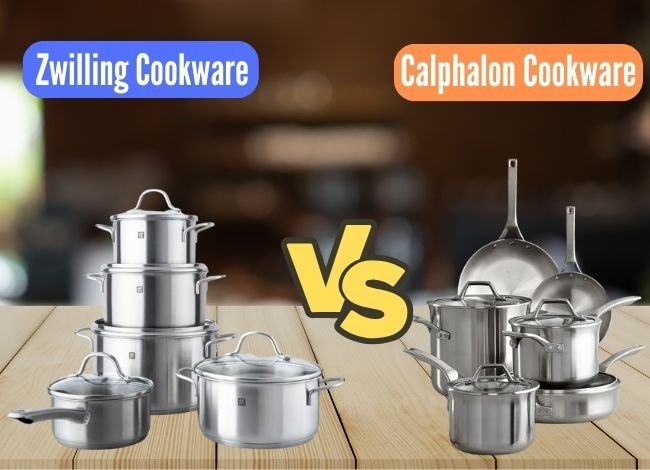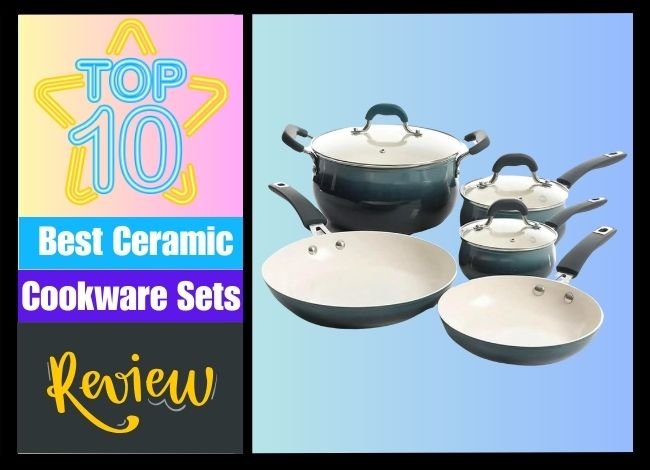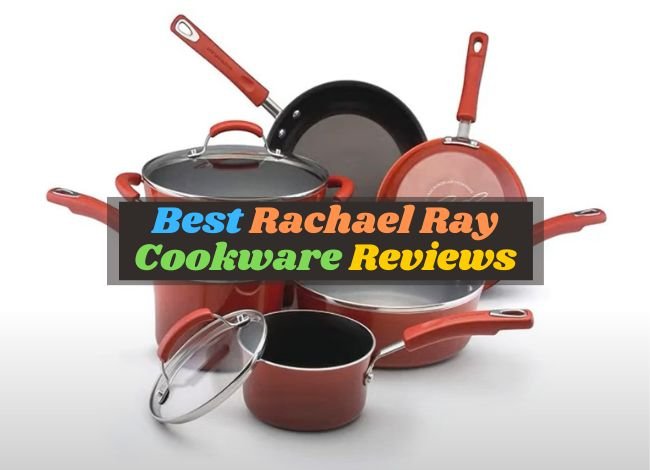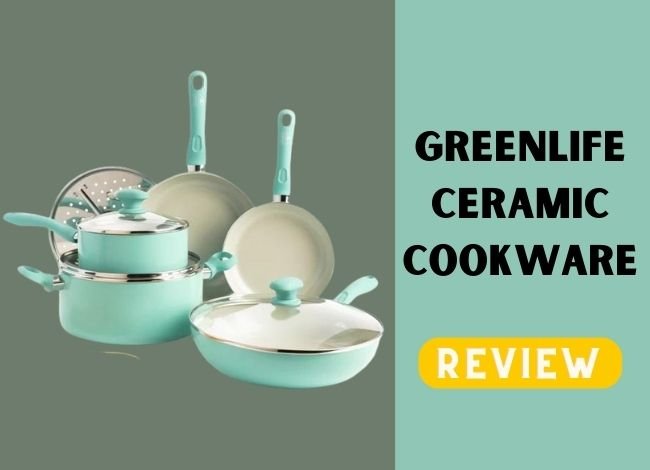Last Updated on February 7, 2024
Zwilling Cookware
Zwilling, a renowned German brand, is celebrated for its exceptional quality and craftsmanship in cookware. With a history dating back to 1731, Zwilling has mastered the art of combining traditional techniques with modern technology. Their cookware range includes pots, pans, and kitchen tools, all designed with precision and durability in mind. Notably, Zwilling specializes in high-quality stainless steel and non-stick cookware, appealing to both professional chefs and home cooking enthusiasts. Their products are known for even heat distribution, ergonomic handles, and resistance to warping and scratching. Additionally, Zwilling’s commitment to sustainability is evident in their environmentally friendly production processes and use of recyclable materials. This dedication to quality and sustainability positions Zwilling as a top choice for those who prioritize longevity and eco-friendliness in their kitchenware.
Calphalon Cookware
Calphalon, an American brand established in the 1960s, has made a significant mark in the cookware industry. It is particularly known for popularizing hard-anodized aluminum cookware, which provides excellent heat conduction and durability. Calphalon offers a diverse range of products, including non-stick, stainless steel, and cast iron cookware. Their non-stick line, especially, is highly regarded for its performance and ease of cleaning. Calphalon cookware features a modern design with attention to functional details such as stay-cool handles and oven-safe capabilities. The brand continually innovates, incorporating features like space-saving designs and multi-layer non-stick coatings. Calphalon products cater to a broad spectrum of culinary needs, from amateur cooks to seasoned chefs. Their commitment to quality and customer satisfaction is evident in their warranty policies and customer service. Calphalon stands out as a reliable choice for those seeking versatility and innovation in their cookware.
Comparison Table: Zwilling vs. Calphalon Cookware
| Feature | Zwilling | Calphalon |
|---|---|---|
| Brand Origin | Germany | USA |
| Material | Stainless steel, Aluminum, Non-stick | Hard-anodized aluminum, Non-stick, Stainless steel |
| Product Range | Wide (pots, pans, knives) | Wide (pots, pans, bakeware) |
| Price Range | $$$ | $$ |
| Durability | Very Durable | Durable |
| Non-Stick Options | Yes | Yes |
| Oven Safety | Up to 500°F | Up to 450°F |
| Dishwasher Safe | Yes | Mostly |
| Warranty | Limited Lifetime | Full Lifetime |
Key Difference: Zwilling vs. Calphalon Cookware
Design
Zwilling cookware boasts a classic European aesthetic, emphasizing elegant lines and a polished finish. This design is both functional and stylish, appealing to those who value traditional kitchen elegance. In contrast, Calphalon offers a modern, sleek design with an emphasis on contemporary shapes and minimalist appeal. Its aesthetic is more aligned with modern kitchen decors, appealing to those who prefer a cutting-edge look in their cookware.
Materials and Construction
Zwilling cookware is renowned for its use of high-quality stainless steel, often combined with aluminum for better heat distribution. This combination ensures durability and longevity. Calphalon, on the other hand, frequently utilizes hard-anodized aluminum, which is known for its excellent heat conduction and scratch resistance. Both brands offer non-stick options, but Calphalon is particularly noted for its advanced non-stick coatings.
Performance
In terms of cooking performance, Zwilling pans heat evenly and are known for their superior heat retention, making them ideal for simmering and slow cooking. Calphalon pans, with their excellent heat conductivity, are great for searing and frying, offering quick and even heating. Both brands are oven-safe, but Zwilling tends to have a higher oven-safe temperature limit.
Quality
Zwilling is synonymous with high quality and durability, often seen as a long-term investment in cookware. Its products are crafted with attention to detail and designed to last years. Calphalon also offers high-quality cookware but focuses on innovative features like non-stick surfaces and unique anodized construction. Both brands offer warranties, reflecting their commitment to quality.
Price
Zwilling cookware is generally priced higher, reflecting its European craftsmanship and premium materials. It is often seen as an investment for serious cooks. Calphalon, while also offering high-quality products, is more budget-friendly and offers a wider range of prices, making it accessible to a broader audience. The choice between the two often comes down to balancing budget considerations with specific cooking needs and preferences.
Which One Should You Pick?
Deciding between Zwilling and Calphalon cookware depends on individual cooking needs and preferences. Zwilling’s high-quality stainless steel and eco-friendly practices are compelling for those valuing tradition and sustainability. Their cookware is ideal for those who enjoy cooking with precision and appreciate lasting durability. On the other hand, Calphalon’s pioneering use of hard-anodized aluminum and advanced non-stick technology appeals to those seeking innovation and convenience in their cooking tools. Calphalon is particularly suitable for busy cooks who prioritize ease of use and maintenance. Both brands offer exceptional quality, but the choice ultimately hinges on whether you prioritize Zwilling’s craftsmanship and sustainability or Calphalon’s technological innovation and convenience.
Conclusion
In conclusion, Zwilling and Calphalon offer exceptional cookware catering to different culinary preferences and needs. Zwilling stands out for its traditional craftsmanship, quality stainless steel products, and commitment to sustainability. Calphalon, on the other hand, excels in innovative design, non-stick technology, and ease of use. Your choice should be guided by your cooking style, material preferences, and value placed on sustainability versus technological innovation. Both brands are reputable and offer high-quality cookware, ensuring that whichever you choose, you’ll invest in a product that enhances your cooking experience.
Frequently Asked Questions
Question: Is Zwilling cookware oven-safe?
Answer: Yes, most Zwilling cookware is oven-safe, but the maximum safe temperature varies depending on the specific product line. It’s essential to check the manufacturer’s guidelines for each item.
Question: Can Calphalon pans go in the dishwasher?
Answer: Some Calphalon pans are dishwasher-safe, but others are not. It’s important to refer to the specific care instructions for each product, as dishwasher use might void the warranty for certain lines.
Question: How does the pricing of Zwilling and Calphalon cookware compare?
Answer: Generally, Zwilling cookware tends to be on the higher end of the price spectrum due to its premium materials and construction. Calphalon offers a wider range of prices, catering to both budget-friendly and higher-end markets.
Question: Are there any non-stick options available in Zwilling’s cookware lines?
Answer: Yes, Zwilling offers non-stick cookware, particularly in their ceramic non-stick lines, which are known for being durable and free of PFOA and PTFE.
Question: What kind of warranty does Calphalon offer on its cookware?
Answer: Calphalon typically offers a limited lifetime warranty on its cookware, covering defects in material and workmanship. However, this warranty does not cover damage caused by misuse, abuse, or normal wear and tear.
Question: Is Zwilling cookware compatible with induction cooktops?
Answer: Many of Zwilling’s cookware lines are compatible with induction cooktops, but it’s crucial to check the specifications for each product, as compatibility can vary.
Question: How does the heat distribution of Calphalon cookware compare to Zwilling?
Answer: Calphalon’s anodized aluminum cookware is known for its excellent heat distribution and retention. Zwilling cookware also offers excellent heat distribution, especially in its stainless steel and copper core lines.
Question: Can I use metal utensils with Zwilling and Calphalon non-stick cookware?
Answer: Wood, plastic, or silicone utensils with non-stick cookware are generally recommended to prevent scratching and damage to the non-stick surface. This applies to both Zwilling and Calphalon non-stick products.
Question: Are there any special care instructions for maintaining Zwilling and Calphalon cookware?
Answer: It’s important to follow the specific care instructions provided for both brands. Generally, hand washing is recommended to prolong the cookware’s life, especially for non-stick surfaces. Avoid using harsh abrasives and ensure cookware is completely dry before storing.




